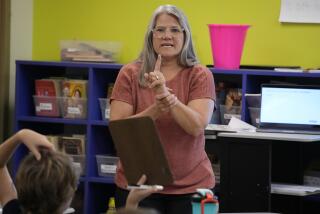Counting Up the Joys of Mathematics
- Share via
Archimedes’ Revenge: The Joys and Perils of Mathematics by Paul Hoffman (W. W. Norton & Co.: $17.95; 285 pages)
Writing about mathematics for general readers is among the trickiest tricks around. The material can be hard to explain (if not unexplainable), and the job is made harder by the longstanding aversion that many readers have for the subject, a phenomenon called “math anxiety.” If bridging two cultures is hard, mathematics is the ne plus ultra of them all.
But there are a few writers who try, all of whom owe a great debt to Martin Gardner, who for 25 years wrote a mathematics column in Scientific American, single-handedly inventing the genre of math for non-mathematicians. Paul Hoffman, now editor in chief of Discover magazine, is one of Gardner’s most successful disciples.
Hoffman’s latest book, “Archimedes’ Revenge,” which is dedicated to Gardner, is a survey of a variety of contemporary topics from number theory to topology to computers to the mathematical paradoxes of voting. He writes with an easy style, and his book is probably more accessible to interested laymen than other recent efforts to popularize math.
There is no particular thread linking the topics that Hoffman chooses, but he approaches each with verve and clarity. Almost all of his topics have been written about before, though they will be new to some readers, and it never hurts to have some old chestnuts explained one more time.
Computer chess, for example, is hardly a new subject. But Hoffman, who was an accomplished chess player in his youth, captures the intricacies of the chess-playing programs at just the right level. He gives neither too much detail nor too little. He has a good sense of what an interested non-specialist needs to know.
Unlike most treatments of math for the layman, Hoffman’s book really does require only a passing prior acquaintance with mathematics. Not even algebra is required to understand what he’s talking about.
He starts with the properties and mysteries of numbers. What could be simpler? Yet it turns out that more than two millennia after people started thinking about these things, much remains unknown.
For example, a number that is the sum of all of its divisors other than itself is called a perfect number. Six is a perfect number. It is the sum of 1, 2 and 3. Twenty-eight is another perfect number. It is the sum of 1, 2, 4, 7 and 14. Are there are any odd perfect numbers? No one knows. None has ever been found, but no one has proved that it’s impossible for there to be one.
One of the prime benefits of a book like Hoffman’s is that it shows how much remains unknown in even the simplest mathematics. Anyone who thinks that mathematics is a finished subject is in for a surprise.
Patterns and Truths
Similarly, anyone who thinks that what mathematicians do is add up numbers will be disabused of that notion. Mathematics has very little do with arithmetic or reckoning. Rather, it is the search for abstract and universal patterns and truths, and its practitioners are among the world’s clearest, most rigorous thinkers.
Much of Hoffman’s book deals with computers in one form or another. Among many other things, he explains how computers are affecting the very nature of how mathematics is done. By enabling mathematicians to try out some of their ideas before actually pursuing them, computers in a sense are turning mathematics into an experimental science, something it has never been.
Since mathematics is supposed to deal with abstract truths divorced from any actual objects in the real world, the notion of doing experiments to discover mathematical truths strikes some people as odd if not heretical.
But as Hoffman makes clear, it is hard to argue with success, and computer-aided mathematicians have achieved some remarkable results. Though some purists may not like it, the computer as a tool of working mathematicians is apparently here to stay.
Still, Hoffman notes that despite all of its achievements (which are many), “There are still subtle limits to what the computer can do.”
And a good thing too.
More to Read
Sign up for our Book Club newsletter
Get the latest news, events and more from the Los Angeles Times Book Club, and help us get L.A. reading and talking.
You may occasionally receive promotional content from the Los Angeles Times.







